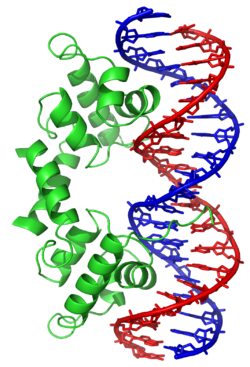- Protein-DNA interaction
-
Protein–DNA interactions are when a protein binds a molecule of DNA, often to regulate the biological function of DNA, usually the expression of a gene. Among the proteins that bind to DNA are transcription factors that activate or repress gene expression by binding to DNA motifs and histones that form part of the structure of DNA and bind to it less specifically.
In general, proteins bind to DNA in the major groove, however there are exceptions.[1]
See also
References
- ^ Bewley CA, Gronenborn AM, Clore GM (1998). "Minor groove-binding architectural proteins: structure, function, and DNA recognition". Annu Rev Biophys Biomol Struct 27: 105–31. doi:10.1146/annurev.biophys.27.1.105. PMID 9646864.
Categories:- Systems biology
- Bioinformatics
- Biochemistry methods
- Biotechnology
Wikimedia Foundation. 2010.

